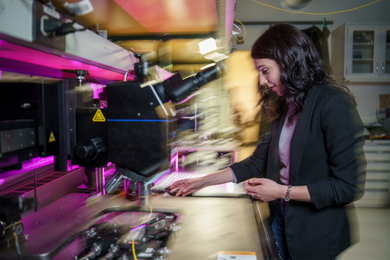Members of the MIT community have had their waterproof boots on the ground in hurricane-ravaged Louisiana and Mississippi not only as civil engineers, soil engineers, architects and volunteers but also as community organizers.
Jessica Berman-Boatright, a graduate student in the Department of Urban Studies and Planning (DUSP), was familiar with New Orleans from her pre-MIT days, when she worked in an architecture and planning firm there. Following last fall's devastating hurricanes, Boatright took the opportunity to go back for the January Independent Activities Period.
With the help of an MIT Public Service Fellowship, Berman-Boatright went to work with three organizations -- the Center for Empowered Decision Making, the planning and design firm Concordia and the Ash̩ Cultural Center, a locus for the African-American community in New Orleans.
She soon found herself organizing a three-day festival of idea- and resource-sharing called "Making It Happen," which took place Jan. 20-22. Its goal was to bring together New Orleans planning practitioners with experienced community development leaders from far and wide, with an eye toward advancing the chaotic and fragmented recovery effort in the city.
Writing by e-mail from New Orleans, Berman-Boatright said, "In the end, I oversaw a 400-person event that took place over five venues, and included seven meals, a bus tour, three different presentation forums and music."
For the spring semester, she took part in "The Katrina Practicum," taught in New Orleans by DUSP faculty members: Phil Thompson, associate professor; JoAnn Carmin, assistant professor; and Caesar McDowell, professor of the practice of community development.
"The class has been researching affordable housing, community development and post-disaster environmental issues on behalf of two community development corporations in New Orleans -- Ujaama Community Development Corp. and Neighborhood Housing Services of New Orleans," Boatright said. The MIT practicum group focused on the historic Trem̩ neighborhood, sometimes identified as the oldest African-American neighborhood in the United States. Some of the students in the practicum remain in New Orleans, immersing themselves in the many environmental, architectural and planning challenges that confront the area residents.
This summer, Boatright is pursuing a housing design and building project in Houma, La., southwest of New Orleans, through an MIT architecture course called "The New Practitioner" taught by Reinhard Goethert, principal research associate in architecture. Goethert is director of the Special Interest Group in Urban Settlement (SIGUS) and an advisor on the LIFT House project, a collaboration of SIGUS, OxFam America and the Terrebonne Readiness Assistance Coalition (TRAC).
The SIGUS team is addressing what types of houses to build, how to build them and how best to balance volunteer and community participation.
Boatright said, "The people I worked with taught me a great deal about determination and perseverance."
Boatright's experiences in New Orleans affect her day-to-day life at MIT, she said. "Perhaps the most meaningful lesson is that there is a responsibility that people like me, who are not from New Orleans but have the opportunity to witness life there, to get a glimpse of what is working and what isn't, to return to our communities and make sure every American understands what is going on in New Orleans."
For more on LIFT House, visit web.mit.edu/newsoffice/2006/katrina-house.html.





